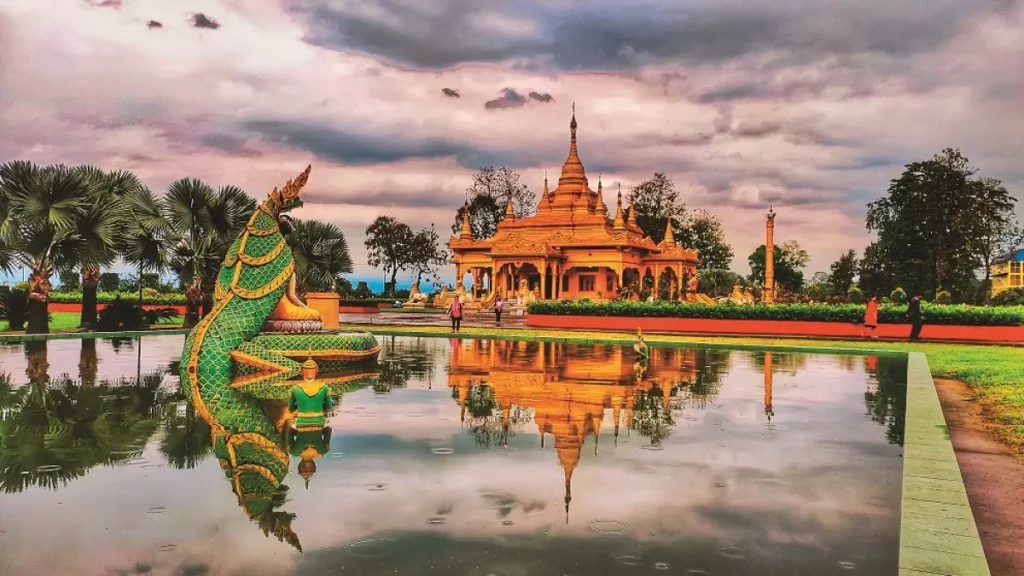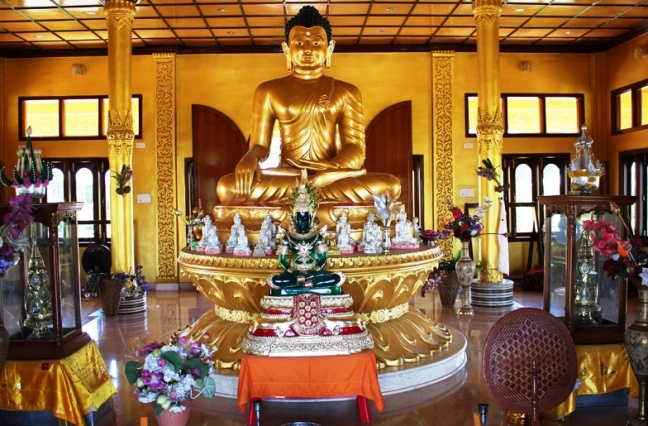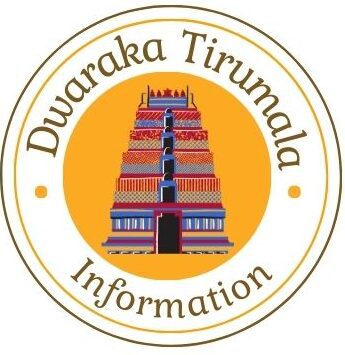

Introduction
Nestled amidst the lush green hills of Namsai in Arunachal Pradesh, India, stands a resplendent monument that captivates visitors with its ethereal beauty. The Golden Pagoda, also known as Kongmu Kham in the local Tai-Khamti language, is a testament to the region’s rich Buddhist heritage. This architectural marvel, adorned in shimmering gold, beckons travelers on a journey of spiritual enlightenment and cultural exploration.
The Golden Pagoda: A Symbol of Peace and Tranquility
The Golden Pagoda is not merely a place of worship; it is a symbol of peace, harmony, and cultural exchange. Its construction, inspired by the revered Shwedagon Pagoda in Yangon, Myanmar, reflects the deep-rooted Buddhist traditions of the region. The pagoda’s golden hue, shimmering under the sun, evokes a sense of tranquility and serenity, inviting visitors to pause and reflect on the deeper meaning of life.
Exploring the Golden Pagoda Complex


The Golden Pagoda complex is spread across 20 hectares of land, offering a serene environment for contemplation and spiritual rejuvenation. The main attraction, of course, is the majestic Golden Pagoda itself. Its intricate architecture, adorned with ornate carvings and golden embellishments, is a sight to behold.
Key Features of the Golden Pagoda
- The Main Pagoda: The centerpiece of the complex, the Golden Pagoda, stands tall, its golden spire piercing the sky. Inside, devotees can find a serene prayer hall, adorned with beautiful murals and statues of Buddha.
- The Buddha Statue: A magnificent bronze statue of Buddha, donated by the Chief Monk of Wat Aranjikavas temple in Thailand, graces the main shrine.


- The Prayer Wheels: Rows of prayer wheels, inscribed with mantras, line the pathways, inviting visitors to spin them and offer prayers.


- The Meditation Hall: A serene space for meditation and contemplation, the meditation hall provides a peaceful retreat for those seeking inner peace.
- The Library: The library houses a collection of religious texts and scriptures, offering insights into Buddhist philosophy and teachings.
The Significance of the Golden Pagoda


The Golden Pagoda holds immense cultural and religious significance for the local community. It serves as a center for Buddhist teachings and practices, attracting devotees from far and wide. The annual Kathina festival, celebrated with great fervor, is a major event at the pagoda, drawing thousands of participants.
Reaching the Golden Pagoda
The Golden Pagoda is well-connected by road and air. The nearest airport is Mohanbari Airport in Dibrugarh, Assam, which is approximately 68 km away. From the airport, visitors can hire a taxi or take a bus to reach Namsai. The nearest railway station is Tinsukia Junction, also in Assam, which is about 68 km from the pagoda.
By Air:
- The nearest airport is Mohanbari Airport in Dibrugarh, Assam, located approximately 68 km away.
- From the airport, you can hire a taxi or take a bus to reach Namsai.
By Train:
- The nearest railway station is Tinsukia Junction, also in Assam, situated about 68 km from the pagoda.
- From Tinsukia, you can hire a taxi or take a bus to reach Namsai.
By Road:
- Namsai is well-connected by road with neighboring towns in Assam.
- Regular buses and taxis are available from nearby towns and cities to Namsai.
- You can also choose to drive to Namsai, enjoying the scenic beauty of the surrounding landscapes.
Temple Timings
The Golden Pagoda is open to visitors from 6:00 AM to 6:00 PM daily.
Best Time to Visit
The best time to visit the Golden Pagoda is during the winter months (October to March) when the weather is pleasant and comfortable.
Nearby Visiting Places
While the Golden Pagoda is a major attraction, Namsai and its surrounding areas offer several other interesting places to explore:
- Parshuram Kund: A revered Hindu pilgrimage site located near Namsai, believed to be the place where Lord Parshuram performed penance.
- Namsai Monastery: A serene Buddhist monastery offering a glimpse into the region’s rich religious heritage.
- Chongkham Monastery: Another significant Buddhist monastery situated on a picturesque river island.
- Lathao Bridge: A unique suspension bridge offering stunning views of the surrounding landscape.
- Wakro: A charming village known for its traditional handicrafts and tribal culture.
- World Peace Pagoda: A serene pagoda offering panoramic views of the surrounding hills.
- Kamlang Tiger Reserve & Wildlife Sanctuary: A haven for wildlife enthusiasts, offering opportunities to spot tigers, elephants, and other endangered species.
These are just a few of the many attractions near the Golden Pagoda. Exploring these places will enrich your understanding of the region’s culture, history, and natural beauty.
Accommodation Options
Several hotels and guesthouses are available near the Golden Pagoda, catering to different budgets and preferences.
- Golden Pagoda Eco Resort: Nestled amidst nature, this resort offers a serene and comfortable stay with stunning views of the surrounding landscape.
- The Woodpeckers Nest: A charming guesthouse known for its warm hospitality and cozy ambiance.
- Hotel Nam Lau: A budget-friendly option with comfortable rooms and basic amenities.
- Circuit House: A government-run accommodation option, suitable for budget travelers.
- Forest Guest House: Another government-run option, offering basic amenities and a peaceful environment.
Please note: It’s advisable to book your accommodation in advance, especially during peak season. You can find more options and book online through travel websites like Booking.com, Agoda, or MakeMyTrip.
Conclusion
The Golden Pagoda stands as a testament to the enduring power of faith and the beauty of Buddhist architecture. Its serene ambiance and spiritual significance make it a must-visit destination for travelers seeking a deeper connection with their inner selves. Whether you are a devout Buddhist or simply a curious traveler, the Golden Pagoda offers a unique and enriching experience.
